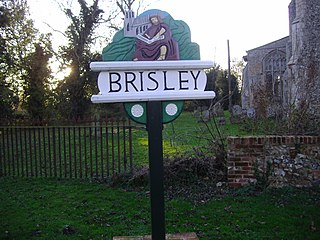This is a list of scheduled monuments in Merseyside , a metropolitan county in England.
This is a list of scheduled monuments in Merseyside , a metropolitan county in England.
None.



Lydiate is a village and civil parish in the Metropolitan Borough of Sefton on Merseyside, England but historically in Lancashire. It is located 1.5 miles (2 km) north of Maghull, with which it has a common history. At the 2001 Census the civil parish of Lydiate had a population of 6,672, reducing to 6,308 at the 2011 Census.

Brisley is a village and civil parish in the English county of Norfolk.

Birkenhead Priory is in Priory Street, Birkenhead, Merseyside, England. It is the oldest standing building on Merseyside. The site comprises the medieval remains of the priory itself, the priory chapter house, and the remains of St Marys church. All three are recorded in the National Heritage List for England, though at different grades.

Binham is a village and a civil parish in the English county of Norfolk. Binham is 29.3 miles (47.2 km) north west of Norwich and 16.9 miles (27.2 km) west of Cromer. The village lies 4.9 miles (7.9 km) east south east of the town of Wells-next-the-Sea.
Grade I, Grade II* and notable Grade IIlisted buildings in the metropolitan boroughs of Knowsley, Liverpool, Sefton, St Helens and Wirral in Merseyside.

Briston is a village, civil parish and electoral ward in the English county of Norfolk.

There are 100 Grade I listed buildings in Bristol, England according to Bristol City Council. The register includes many structures which for convenience are grouped together in the list below.

Bridgham is a village and civil parish in the English county of Norfolk.

Cannington is a village and civil parish 3 miles (5 km) northwest of Bridgwater in Somerset, England. It lies on the west bank of the River Parret, and contains the hamlet of Edstock.

The Grade I listed buildings in Somerset, England, demonstrate the history and diversity of its architecture. The ceremonial county of Somerset consists of a non-metropolitan county, administered by Somerset County Council, which is divided into five districts, and two unitary authorities. The districts of Somerset are West Somerset, South Somerset, Taunton Deane, Mendip and Sedgemoor. The two administratively independent unitary authorities, which were established on 1 April 1996 following the breakup of the county of Avon, are North Somerset and Bath and North East Somerset. These unitary authorities include areas that were once part of Somerset before the creation of Avon in 1974.
Charles Harrison Townsend was an English architect. He was born in Birkenhead, educated at Birkenhead School and articled to the Liverpool architect Walter Scott in 1870. He moved to London with his family in 1880 and entered partnership with the London architect Thomas Lewis Banks in 1884. Townsend became a member of the Art Workers' Guild in 1888 and in the same year was elected a Fellow of the more conservative Royal Institute of British Architects. He remained an active member of both organisations throughout his career and was elected Master of the Art Workers' Guild in 1903. He is important Modern Style architect whose favourite motif was the tree.

The Church of St Mary is the parish church of Cannington, Somerset, England. The parish is in the Church of England Diocese of Bath and Wells.

Cannington Court in the village of Cannington, Somerset, England was built around 1138 as the lay wing of a Benedictine nunnery, founded by Robert de Courcy. It has been designated as a Grade I listed building.
Buckland Priory was established around 1167 in Lower Durston, Somerset, England.

Cannington Priory was a Benedictine nunnery established around 1138 and dissolved in 1536 in Cannington, Somerset, England.

Brockworth Court is a Tudor house in the village of Brockworth, Gloucestershire, England. Dating from the 16th century, it is a Grade II* listed building.

St Michael's Church is a Grade II* listed Gothic Victorian church in Bournemouth, Dorset, England.

Grove Gardens Chapel is a Grade II listed building in Richmond Old Cemetery, in the London Borough of Richmond upon Thames. It was built in 1877 by Sir Arthur Blomfield in the Gothic Revival style as the Anglican chapel for the cemetery. It is currently in the care of Habitats & Heritage.

Robin Hood's Stone, also known as The Archer Stone is a Bronze age standing stone and scheduled monument in Liverpool, UK.